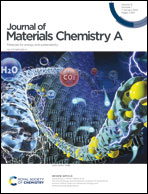Understanding the constant-voltage fast-charging process using a high-rate Ni-rich cathode material for lithium-ion batteries†
Abstract
Fast-charging of lithium-ion batteries is a critical requirement for wider adoption of electric vehicles. However, it is subject to several difficulties, such as inhomogeneous delithiation, local heating, and lithium plating. Various charging protocols have been developed to resolve these problems, most of which comprise the combinations of constant-current (CC) and constant-voltage (CV) charging steps. Although it is one of the two main components in conventional charging protocols, CV charging is usually applied in a restrictive manner only to supplement CC charging, and its potential implications as a fast-charging protocol have not yet been fully explored. Herein, we study the effects of a CV-only charging protocol on the fast-charging efficiency of high-rate LiNi0.8Co0.1Mn0.1O2 cathode particles prepared by ultrasonic spray pyrolysis. A 15 minute full-charging is achieved by a single CV charging step without a significant capacity loss in the early cycles. However, gradual degradation of specific capacity and charging efficiency was observed at later cycles. Based on electro- and physico-chemical analysis data, we propose a two-step CV charging protocol that can improve the cycle stability alleviating the damage to the cathode particles. By revisiting CV charging protocols, this work provides a better understanding of the CV charging process that can contribute to the design of new charging protocols with advanced fast chargeability.



 Please wait while we load your content...
Please wait while we load your content...